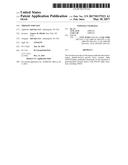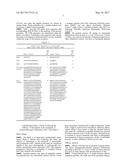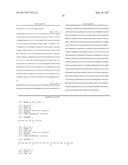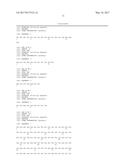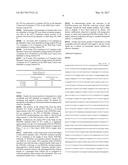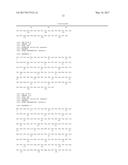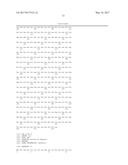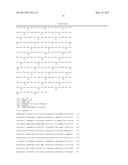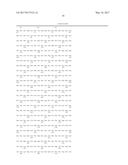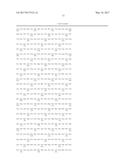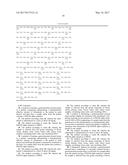Patent application title: THERAPY FOR GIST
Inventors:
Gaurav D. Shah (New York, NY, US)
Assignees:
IMCLONE LLC
IPC8 Class: AC07K1628FI
USPC Class:
1 1
Class name:
Publication date: 2017-05-18
Patent application number: 20170137523
Abstract:
The invention provides for the human antibodies that bind to human
platelet-derived growth factor receptor alpha (PDGFR alpha), preferably
olaratumab, for the treatment of gastrointestinal stromal tumors with
PDGFR alpha mutations including D842V.Claims:
1-25. (canceled)
26. A method of treating a gastrointestinal stromal tumor in a patient, comprising administering a therapeutically effective amount of olaratumab to the patient in need thereof, provided that a sample taken from the patient contains a PDGFR alpha mutation.
27. The method according claim 26, wherein the olaratumab is administered at a dose of about 20 mg/kg.
28. The method according to claim 26, wherein the PDGFR alpha mutation is D842V.
29. The method according to claim 26, wherein the sample is selected from the group consisting of blood, serum, plasma, urine, tissue, tumor cells, tumor tissue samples, circulating tumor cells, and circulating DNA.
30. A method of treating a gastrointestinal stromal tumor in a patient, comprising administering a therapeutically effective amount of olaratumab to the patient in need thereof, provided that the patient is selected for treatment on the basis of a sample taken from the patient that contains a PDGFR alpha mutation.
31. The method according claim 30, wherein the olaratumab is administered at a dose of about 20 mg/kg.
32. The method according to claim 30, wherein the PDGFR alpha mutation is D842V.
33. The method according to claim 30, wherein the sample is selected from the group consisting of blood, serum, plasma, urine, tissue, tumor cells, tumor tissue samples, circulating tumor cells, and circulating DNA.
34. A method of identifying a gastrointestinal stromal tumor patient eligible for treatment with olaratumab, comprising assaying for the presence of a PDGFR alpha mutation by DNA or RNA sequencing of a sample taken from the patient prior to the administration of a therapeutically effective amount of olaratumab, wherein the patient is eligible for treatment with olaratumab if the PDGFR alpha mutation is present in the sample.
35. The method according to claim 34, wherein the olaratumab is administered at a dose of about 20 mg/kg.
36. The method according to claim 34, wherein the PDGFR alpha mutation is D842V.
37. The method according to claim 34, wherein the sample is selected from the group consisting of blood, serum, plasma, urine, tissue, tumor cells, tumor tissue samples, circulating tumor cells, and circulating DNA.
38. A therapeutic regimen for treating a gastrointestinal stromal tumor, comprising: (1) selecting a patient having a gastrointestinal stromal tumor on the basis of a sample taken from the patient having a PDGFR alpha mutation, wherein the sample is selected from the group consisting of blood, serum, plasma, urine, tissue, tumor cells, tumor tissue samples, circulating tumor cells, and circulating DNA, and (2) administering to the patient olaratumab if the mutation is present.
39. The therapeutic regimen according to claim 38, wherein the mutation of PDGFR alpha is D842V.
40. The therapeutic regimen according to claim 38, wherein the olaratumab is administered at a dose of about 20 mg/kg.
Description:
[0001] This application claims the benefit of U.S. Provisional Application
No. 62/020,429 which was filed 3 Jul. 2014.
[0002] This invention is directed to the fields of immunology and cancer treatment. More specifically, the present invention is directed to olaratumab to treat gastrointestinal stromal tumors (GIST), preferably those harboring the platelet-derived growth factor receptor alpha (PDGFR.alpha.) D842V mutation, and as a medicament for the treatment of GIST.
[0003] GIST are mesenchymal neoplasms that arise predominantly in the gastrointestinal tract (GI) including the stomach and small intestine. GIST includes tumors once diagnosed (prior to the molecular profiling of GIST) as gastrointestinal leiomyomas, leiomyoblastomas, leiomyosarcomas, neurofibromas, or schwannomas. Most GIST are driven by activating mutations in the KIT tyrosine kinase receptor however, a small proportion (5%-7%) of GIST have activating mutations in the related kinase PDGFR.alpha.. Biron T. et. al. J Clin Oncol. 2010; 28:15s (suppl; abstr 10051). The KIT and PDGFR.alpha. activating mutations are mutually exclusive (Corless C., et. al. Nature Reviews, Cancer. 2011; 11: 865-878), although recent evidence indicates that drug-resistant GIST bearing KIT mutations may acquire secondary mutations to PDGFR.alpha. (Debiec-Rychter M. et. al. Gastroenterology 2005; 128:270-279). The present invention is a response to a clinically unmet need for treatment of GIST, specifically those with a PDGFR.alpha. mutation. Olaratumab for the treatment of GIST provides unexpected clinical benefit for this patient population with such mutations.
[0004] Surgical resection is the optimal approach to primary GIST without evidence of metastases. However, recurrence within five years is fairly common even for completely resected tumors. Conventional cytotoxic chemotherapy is associated with typical response rates of 5% or less, and the median survival for patients with metastatic/unresectable GIST is only 5-12 months.
[0005] Approved non-surgical treatment options include three small molecule tyrosine kinase inhibitors (TKI): imatinib (targeting KIT and PDGFR.alpha.; approved for KIT positive unresctable and/or metastatic malignant GIST), sunitinib (targeting KIT and PDGFR.alpha.; approved for GIST after disease progression on, or intolerance to, imatinib), and regorafenib (targeting KIT, PDGFR.alpha. and vascular endothelial growth factor receptor (VEGFR); approved for advanced GIST that cannot be surgically removed and no longer respond to imatinib and sunitinib), that are approved as single-agent therapy for the treatment of unresectable or metastatic GIST in the first-, second-, and third-line respectively. Corless C., et. al. Nature Reviews, Cancer. 2011; 11: 865-878.
[0006] Aberrant activation resulting in constitutive, ligand-independent activity of PDGFR.alpha. through mutation may be linked to resistance to other GIST treatments. A number of PDGFR.alpha. mutations are known (Corless C L, et. al. J Clin Oncol 2005; 23:5357-5364) however, their roles in GIST are still being be clarified. One mutation that may play a role in this resistance mechanism is PDGFR.alpha. D842V. However, the role and efficacy of targeting PDGFR.alpha. mutations, including the D842V PDGFR.alpha. mutation, are uncertain and remain the subject of investigation and debate amongst those of skill in the art. Zoler M, Published on Mar. 3, 2014 at http://www.oncologypractice.com/topics/sarcoma-gist/single-article-page/r- ole-for-gist-genotyping-stirs-controversy/800d33412028870aef488cd0df0ca190- ?email=MARCHESANI@LILLY.COM&ocid=1133957.html. Accordingly, the effect and magnitude of efficacy of PDGFR.alpha. inhibitors for GIST patients with PDGFR.alpha. mutations are currently being debated.
[0007] Current data suggest that unresectable or metastatic GIST patients who have non-acquired PDGFR.alpha.-activating mutations such as PDGFR.alpha. D842V, tend to be resistant or unresponsive to imatinib (Cassier P., et. al. Clin Cancer Res. 2012; first published online at Jun. 20, 2012 and Corless C L, et. al. J Clin Oncol 2005; 23:5357-5364) and sunitinib (Heinrich M C, et. al. J Clin Oncol. 2008; 26(33):5352-5359). The median progression-free survival (PFS) of patients with PDGFR.alpha. D842V is only approximately 12 weeks despite treatment with imatinib. Biron T. et. al. J Clin Oncol. 2010; 28:15s (suppl; abstr 10051). Given the limited efficacy of imatinib and sunitinib for GIST that harbor PDGFR.alpha. mutations and for patients whose disease becomes refractory to both imatinib and sunitinib, new treatments for these subpopulations of patients are needed.
[0008] It remains unclear whether a PDGFR.alpha. inhibitor will be an effective treatment for this patient population. Recent early studies with crenolanib, a TKI small molecule inhibitor that targets PDGFR.alpha. including the D842V mutation, has shown efficacy in pre-clinical models; crenolanib is currently being investigated in a phase 2 study. Heinrich M C, et. al. Clin Cancer Res. 2012; 18; 4375. However, as a small molecule TKI, it lacks the specificity as well as potentially some of the functionality of the presently described invention. Accordingly, new, efficacious, and well-tolerated treatments for GIST that provide a clinical benefit are greatly needed for this patient population.
[0009] In short, there is a high unmet clinical need for new, efficacious, and well tolerated treatments for GIST that provide a clinical benefit. Additionally, there is a high unmet clinical need for new, efficacious, and well tolerated treatments for GIST patients whose disease becomes refractory to both imatinib and sunitinib, that provide a survival benefit. Additionally, there is a high unmet clinical need for new, efficacious, and well tolerated treatments for GIST patients with PDGFR.alpha. mutations that provide a survival benefit. More specifically, there is a high unmet clinical need for new, efficacious, and well tolerated treatments for GIST patients with the D842V PDGFR.alpha. mutation that provide a survival benefit.
[0010] A novel use of olaratumab for the treatment of GIST, especially GIST with PDGFR.alpha. mutations, more specifically the D842V mutation, is herein presented. Olaratumab, IMC-3G3 (U.S. Pat. Nos. 8,128,929 and 8,574,578), is a recombinant human monoclonal antibody which specifically targets PDGFR.alpha.. The patents disclose the treatment of a variety of neoplastic diseases, including soft tissue sarcomas, with PDGFR.alpha. antibodies, including IMC-3G3. The present invention was studied in a Phase 2 trial (http://www.clinicaltrials.gov/ct2/show/NCT01316263?term=3G3&rank=8) (hereinafter "Study"). Neither the patents nor the Study design provide any suggestion of the role or efficacy of targeting PDGFR.alpha. mutations and more specifically the D842V mutation.
[0011] The results of the Study illustrate an unexpected benefit especially for GIST patients harboring PDGFR.alpha. mutations (including D842V) as compared to PDGFR.alpha. wild-type GIST patients. The median PFS in the Study was 32.1 weeks for the PDGFR.alpha. mutated cohort as compared to 6.1 weeks for the PDGFR.alpha. wild-type/non-mutated cohort.
[0012] Furthermore, a median PFS in the Study for the PDGFR.alpha. mutated cohort of 32.1 weeks is a significant improvement over the approximately 12 weeks median PFS for PDGFR.alpha. D842V mutated patients treated with imatinib as disclosed in the art. Biron T. et. al. J Clin Oncol. 2010; 28:15s (suppl; abstr 10051).
[0013] Additionally, a clear trend can be seen in clinical efficacy: at 32 weeks, 29% of patients in the Study harboring a PDGFR.alpha. mutation had yet to demonstrate disease progression while all of the patients identified as PDGFR.alpha. wild-type, including patients with non-mutated PDGFR.alpha., demonstrated disease progression at 32 weeks. This trend is clinically significant in light of the nature of GIST. Therefore, patients harboring a PDGFR.alpha. mutation treated with olaratumab had a clinical benefit as compared to PDGFR.alpha. wild-type patients when treated with olaratumab.
[0014] According to the first aspect of the present invention, there is provided a method of treating a gastrointestinal stromal tumor in a patient, comprising administering a therapeutically effective amount of olaratumab to the patient in need thereof, provided that a sample taken from the patient contains a PDGFR alpha mutation.
[0015] In another aspect of the invention, there is provided a method of treating a gastrointestinal stromal tumor in a patient, comprising administering a therapeutically effective amount of olaratumab to the patient in need thereof, provided that the patient is selected for treatment on the basis of a sample taken from the patient that contains a PDGFR alpha mutation.
[0016] Yet another aspect of the present invention is a method of treating a gastrointestinal stromal tumor in a patient, comprising assaying a sample taken from the patient for a PDGFR alpha mutation prior to administering olaratumab, and administering to the patient a therapeutically effective amount of olaratumab if the PDGFR alpha mutation is present in the sample.
[0017] Another aspect of the present invention is an in vitro method of selecting a patient having a gastrointestinal stromal tumor for treatment with a therapeutically effective amount of olaratumab, comprising assaying for the presence of a PDGFR alpha mutation in a sample taken from the patient, wherein the patient is selected for treatment with olaratumab if the PDGFR alpha mutation is present in the sample.
[0018] One aspect of the invention is a method of identifying a gastrointestinal stromal tumor patient eligible for treatment with olaratumab, comprising assaying for the presence of a PDGFR alpha mutation by DNA or RNA sequencing of a sample taken from the patient prior to the administration of a therapeutically effective amount of olaratumab, wherein the patient is eligible for treatment with olaratumab if the PDGFR alpha mutation is present in the sample.
[0019] Another aspect of the invention is an improved method of treating a patient having a gastrointestinal stromal tumor with olaratumab, the method comprising determining the presence of a PDGFR alpha mutation in a sample taken from the patient, and wherein the mutation is determined prior to administration of a therapeutically effective amount of olaratumab.
[0020] In a preferred aspect of the invention relating to the methods disclosed above, the olaratumab is administered at a dose of about 20 mg/kg.
[0021] One aspect of the present invention is a method of predicting the response of a gastrointestinal stromal tumor patient to treatment with olaratumab, comprising assaying a sample taken from the patient to determine the presence of a PDGFR alpha mutation in the sample, wherein the presence of a mutation in the sample is predictive of the patient's effective response to olaratumab.
[0022] Another aspect of the present invention is an in vitro method of predicting the response of a gastrointestinal stromal tumor patient to the administration of olaratumab, comprising performing DNA or RNA sequencing on a sample taken from the patient, wherein the presence of a PDGFR alpha mutation indicates an increased likelihood that the patient will effectively respond to the administration of olaratumab.
[0023] In a preferred aspect of the invention relating to the methods disclosed above, the PDGFR alpha mutation is D842V.
[0024] In a preferred aspect of the invention relating to the methods disclosed above, the sample is selected from the group consisting of blood, serum, plasma, urine, tissue, tumor cells, tumor tissue samples, circulating tumor cells, and circulating DNA.
[0025] One aspect of the invention is a therapeutic regimen for treating a gastrointestinal stromal tumor, comprising: (1) selecting a patient having a gastrointestinal stromal tumor on the basis of a sample taken from the patient having a PDGFR alpha mutation, wherein the sample is selected from the group consisting of blood, serum, plasma, urine, tissue, tumor cells, tumor tissue samples, circulating tumor cells, and circulating DNA, and (2) administering to the patient olaratumab if the mutation is present. In a preferred aspect of this invention, the mutation of PDGFR alpha is D842V. In another preferred aspect of this invention, the olaratumab is administered at a dose of about 20 mg/kg.
[0026] In another aspect of the invention, there is provided a pharmaceutical composition comprising olaratumab with one or more pharmaceutically acceptable carriers, diluents, or excipients, for use in the treatment of a gastrointestinal stromal tumor having a PDGFR alpha mutation. In a preferred aspect of this invention, the mutation of PDGFR alpha is D842V. In another preferred aspect of this invention, the olaratumab is administered at a dose of about 20 mg/kg.
[0027] Use of olaratumab in the manufacture of a medicament for the treatment of a gastrointestinal stromal tumor with a PDGFR alpha mutation is another aspect of the present invention. In a preferred aspect of this invention, the mutation of PDGFR alpha is D842V. In another preferred aspect of this invention, the olaratumab is administered at a dose of about 20 mg/kg.
[0028] One aspect of the present invention is olaratumab for use in the treatment of a gastrointestinal stromal tumor with a PDGFR alpha mutation. In a preferred aspect of this invention, the mutation of PDGFR alpha is D842V. In another preferred aspect of this invention, the olaratumab is administered at a dose of about 20 mg/kg.
[0029] Yet another aspect of the present invention is olaratumab for use in treating a gastrointestinal stromal tumor, comprising the steps: (1) assaying a sample from a patient, wherein the sample is selected from the group consisting of blood, serum, plasma, urine, tissue, tumor cells, tumor tissue samples, circulating tumor cells, and circulating DNA, (2) determining the presence of a PDGFR alpha mutation in the sample taken from the patient, wherein the mutation of PDGFR alpha is D842V, and (3) administering olaratumab to the patient if the mutation is present. In a preferred aspect of this invention, the olaratumab is administered at a dose of about 20 mg/kg.
[0030] The present invention also contemplates the following non-limiting list of embodiments, which are further described elsewhere herein:
[0031] According to a preferred embodiment of the present invention, there is provided a pharmaceutical composition of olaratumab for use in therapy of GIST wherein the olaratumab is administered on a 14-day cycle, wherein each dose of olaratumab falls within the range of about 10 mg/kg to about 30 mg/kg. Preferably the dose is in the range of about 18.5 mg/kg to about 22.5 mg/kg and most preferably is about 20 mg/kg. Preferably, patients should be treated in cycles of 14 days until evidence of confirmed disease progression.
[0032] The invention provides for olaratumab in various aspects disclosed herein. Olaratumab is an antibody specific for human PDGFR alpha and comprising the sequences disclosed in TABLE 1: (1) the 6 CDR amino acid sequences (CDRH1, CDRH2, CDRH3, CDRL1, CDRL2, CDRL3); (2) the heavy chain variable region (VH) and the light chain variable region (VL); (3) the a heavy chain and the light chain; or (4) two heavy chains and two light chains.
[0033] The invention also provides for olaratumab for use in the treatment of a gastrointestinal stromal tumor with a PDGFR.alpha. mutation wherein the PDGFR.alpha. mutation is D842V.
[0034] The invention also provides for olaratumab for use in the treatment of a gastrointestinal stromal tumor with a PDGFR.alpha. mutation wherein the olaratumab is administered at a dose of about 20 mg/kg.
[0035] The invention also provides for olaratumab for use in the treatment of a gastrointestinal stromal tumor with a PDGFR.alpha. mutation wherein the PDGFR.alpha. mutation is D842V and wherein the olaratumab is administered at a dose of about 20 mg/kg.
[0036] As used herein, the term "antigen" includes a protein located on a cell's surface. Antigens can include polypeptides, carbohydrates, nucleic acids, lipids, haptens or other naturally occurring or synthetic compounds. Preferably, the antigen is a folded polypeptide or protein. Specific ligands bind the protein or receptor, initiating signal transduction and a change in cellular activity. Antibodies can also bind the antigen which can block ligand binding and the resulting signal transduction. The terms antigen, "receptor," "target" or "target antigen" are used interchangeably herein.
[0037] The terms "platelet-derived growth factor receptor alpha," "platelet-derived growth factor receptor .alpha.," "PDGFR alpha," "PDGFR.alpha.," "PDGF alpha receptor," and "PDGF.alpha. receptor" are used interchangeably herein, unless otherwise indicated, and are intended to refer to the human type III receptor tyrosine kinase, as well as functionally active, mutated forms thereof, that bind human platelet-derived growth factor. Specific examples of PDGFR.alpha. include, e.g., a human polypeptide encoded by the nucleotide sequence provided in GenBank.RTM. accession no. NM_006206.4 (SEQ ID NO 13), or the human protein encoded by the polypeptide sequence provided in GenBank.RTM. accession no. NP_006197.1.
[0038] PDGFR.alpha. is a receptor tyrosine kinase that can be activated by platelet-derived growth factor (PDGF)-AA, -AB, -BB, and -CC. These growth factors are dimeric molecules composed of disulfide-linked polypeptide chains that bind to two receptors simultaneously and induce receptor dimerization, autophosphorylation, and down-stream intracellular signaling. PDGFR.alpha. is expressed in many mesenchymal structures and PDGFR.alpha. plays a critical role during early and later stages of development.
[0039] As used herein, the term "mutation" includes changes in the nucleotide sequence of the genome including changes in the amino acid sequence of the antigen. Mutations are an anomaly or change in the sequence of the antigen that deviates from what is wild type, standard, normal or expected.
[0040] Mutations in the receptor may be determined in a diagnostic or prognostic assay by evaluating extracted and purified DNA of the PDGFR.alpha. exons (specifically exons 12, 14, and 18) by direct, bidirectional sequencing, or real time PCR amplification followed by DNA sequencing. Other methods to detect the mutations include RNA sequencing, high resolution melting (HRM) techniques and nucleotide hybridization.
[0041] The presence of a mutation may be detected in a sample taken from the patient. The patient sample may be blood, serum, plasma, urine, tissue, tumor cells, tumor tissue samples, circulating tumor cells, and circulating DNA.
[0042] As used herein, the term "olaratumab"--also known as IMC-3G3, CAS registry number 1024603-93-7--refers to an anti-PDGFR.alpha. antibody comprising: two heavy chains, each of whose amino acid sequence is that given in SEQ ID NO: 9, and two light chains, each of whose amino acid sequence is that given in SEQ ID NO: 10. U.S. Pat. Nos. 8,128,929 and 8,574,578.
[0043] Olaratumab is a recombinant human monoclonal antibody of the IgG.sub.1 isotype that specifically targets human PDGFR.alpha.. The antibody possesses high-affinity binding for PDGFR.alpha. and blocks platelet-derived growth factor-AA (PDGF-AA), -BB, and -CC ligands from binding to the receptor. As a result, olaratumab inhibits ligand-induced receptor autophosphorylation and phosphorylation of the downstream signaling molecules protein kinase B (Akt) and mitogen-activated protein kinase (MAPK). Olaratumab inhibits the proliferation and growth of a variety of human tumor cell lines.
[0044] As used herein, the term "antibody" includes immunoglobulin molecules comprising four polypeptide chains: two heavy (H) chains and two light (L) chains inter-connected by disulfide bonds. Individual chains can fold into domains having similar sizes (110-125 amino acids) and structures, but different functions. Antibody may be abbreviated herein as "Ab."
[0045] The light chain can comprise one variable domain (VL) and/or one constant domain (abbreviated herein as CL). The light chains of human antibodies (immunoglobulins) are either kappa (.kappa.) light chains or lambda (.lamda.) light chains. The expression VL, as used herein, is intended to include both the variable regions from kappa-type light chains (VK) and from lambda-type light chains (V.lamda.). The heavy chain can also comprise one variable domain (VH) and/or, depending on the class or isotype of antibody, three or four constant domains (CH1, CH2, CH3 and CH4) (abbreviated herein collectively as CH). In humans, the isotypes are IgA, IgD, IgE, IgG, and IgM, with IgA and IgG further subdivided into subclasses or subtypes (IgA.sub.1-2 and IgG.sub.1-4). The present invention includes antibodies of any of the aforementioned classes or subclasses. Human IgG.sub.1 is the preferred isotype for the antibodies of the present invention.
[0046] Three regions, called hypervariable or complementarity-determining regions (hereinafter "CDRs"), are found in each of VL and VH, which are supported by less variable regions called frameworks (herein as "FR"). Amino acids are assigned to a particular CDR region or domain in accordance with various conventions including, but not limited to: Kabat (Kabat, et al., Sequences of Proteins of Immunological Interest, Fifth Edition, U.S. Department of Health and Human Services, NIH Publication No. 91-3242 (1991)), Chothia (Chothia, et al., J Mol Biol. 1987; 196: 901-917. Chothia, et al., Nature. 1989; 342: 877-883), and/or Oxford Molecular AbM antibody modelling software (http://www.bioinf.org.uk/abs/). Each VH and VL is composed of three CDRs and four FRs, arranged from amino-terminus to carboxy-terminus in the following order: FR1-CDR1-FR2-CDR2-FR3-CDR3-FR4. The portion of an antibody consisting of VL and VH domains is designated Fv (Fragment variable) and constitutes the antigen-binding site.
[0047] The term "isolated" refers to an antibody, protein, peptide or nucleic acid that is free or substantially free from other macromolecular species found in a cellular environment. "Substantially free," as used herein means the protein peptide or nucleic acid of interest comprises more than 80% (on a molar basis) of the macromolecular species present, preferably more than 90% and more preferably more than 95%. Examples of "isolated" antibodies include an antibody that has been affinity purified, an antibody that has been made by a hybridoma or other cell line in vitro, and a human antibody derived from a transgenic mouse.
[0048] The term "monoclonal," as used herein, refers to an antibody obtained from a population of substantially homogeneous antibodies, e.g., the individual antibodies comprising the population are substantially identical except for possible naturally occurring mutations or minor post-translational variations that may be present. Monoclonal antibodies are highly specific, being directed against a single antigenic site (also known as determinant or epitope). Furthermore, in contrast to conventional (polyclonal) antibody preparations that typically include different antibodies directed against different determinants, each monoclonal antibody is directed against a single determinant on the antigen. The modifier "monoclonal" indicates the character of the antibody as being obtained from a substantially homogeneous population of antibodies, and is not to be construed as requiring production of the antibody by any particular method. Monoclonal antibody may be abbreviated herein as "mAb."
[0049] The term "human antibody," as used herein, includes antibodies having variable and constant regions corresponding to human germline immunoglobulin sequences (as described in Kabat et al., supra). The human antibodies of the invention may include amino acid residues not encoded by human germline immunoglobulin sequences (e.g., mutations introduced by random or site-specific mutagenesis in vitro or by somatic mutation in vivo), for example in the CDRs. The human antibody can have at least one position replaced with an amino acid residue, e.g., an activity enhancing amino acid residue which is not encoded by the human germline immunoglobulin sequence. However, the term "human antibody," as used herein, is not intended to include antibodies in which CDR sequences derived from the germline of another mammalian species, such as a mouse, have been grafted onto human framework sequences. Methods of producing a "human antibody," as used herein are not intended to include antibodies produced in a human being.
[0050] The phrase "recombinant human antibody" includes human antibodies that are prepared, expressed, created or isolated by recombinant means, such as antibodies expressed using a recombinant expression vector transfected into a host cell, antibodies isolated from a recombinant, combinatorial human antibody library, antibodies isolated from an animal that is transgenic for human immunoglobulin genes, or antibodies prepared, expressed, created or isolated by any other means that involves splicing of human immunoglobulin gene sequences to other DNA sequences. Such recombinant human antibodies have variable and constant regions derived from human germline immunoglobulin sequences.
[0051] Thus, antibodies of the invention include, but are not limited to, isolated antibodies, human antibodies, humanized antibodies, recombinant human antibodies, monoclonal antibodies, digestion fragments, specified portions and variants thereof, including antibody mimetics or comprising portions of antibodies that mimic the structure and/or function of an antibody or specified fragment or portion thereof; each containing at least one CDR.
[0052] Specificity of antibodies or fragments thereof can be determined based on affinity. Affinity, represented by the equilibrium constant for the dissociation of an antigen with an antibody (K.sub.D), measures the binding strength between an antigenic determinant and an antibody-binding site. Affinity can be measured for example by surface plasmon resonance.
[0053] The antibodies of the invention bind to an epitope of PDGFR.alpha. located on the extracellular domain segments (hereinafter referred simply to as "domains" or "ECD"). The term "epitope" as used herein refers to discrete, three-dimensional sites on an antigen that are recognized by the antibodies of the invention.
[0054] In addition to the antibodies specifically described herein, other "substantially homologous" modified antibodies can be readily designed and manufactured utilizing various recombinant DNA techniques well known to those skilled in the art. For example, the framework regions can vary from the native sequences at the primary structure level by several amino acid substitutions, terminal and intermediate additions and deletions, and the like. Moreover, a variety of different human framework regions may be used singularly or in combination as a basis for the humanized immunoglobulins of the present invention. In general, modifications of the genes may be readily accomplished by a variety of well-known techniques, such as site-directed mutagenesis.
[0055] The present invention includes nucleic acid sequences that encode an anti-PDGFR.alpha. antibody heavy chain, comprising any one of the VH regions or a portion thereof, or any one of the VH CDRs, including any variants thereof, as disclosed herein. The invention also includes nucleic acid molecules that encode an anti-PDGFR.alpha. antibody light chain comprising any one of the VL regions, or a portion thereof or any one of the VL CDRs, including any variants thereof as disclosed herein. The invention also includes the nucleic acid sequences of olaratumab, SEQ ID NOs 11 and 12 for heavy chain and light chain, respectively. The antibodies of the invention include antibodies comprising the same CDR regions of olaratumab, and/or the same light chain variable region and/or heavy chain variable region of olaratumab.
[0056] The antibodies of the present invention may be produced by methods known in the art. These methods include the use of transgenic animal, phage display and the immunological method described by Kohler and Milstein, Nature 256: 495-497 (1975); Laboratory Techniques in Biochemistry and Molecular Biology, Volume 13 (Burdon et al. eds., Elsevier Science Publishers, Amsterdam) in Monoclonal Antibody Technology, The Production and Characterization of Rodent and Human Hybridomas (Campbell ed., 1984); as well as by the recombinant DNA method described by Huse et al., Science 246: 1275-1281 (1989).
[0057] It is understood that amino acid residues that are primary determinants of binding of single domain antibodies can be within Kabat, Chothia, AbM, or a combination thereof defined CDRs, but may include other residues as well, such as, for example, residues that would otherwise be buried in the VH-VL interface of a VH-VL heterodimer.
[0058] Preferred host cells for transformation of vectors and expression of the antibodies of the present invention are mammalian cells, e.g., NSO cells, 293, SP20 and CHO cells and other cell lines of lymphoid origin such as lymphoma, myeloma, or hybridoma cells. Other eukaryotic hosts, such as yeasts, can be alternatively used.
[0059] The antibodies of the present invention may be isolated or purified by any method known in the art, including precipitation by ammonium sulfate or sodium sulfate followed by dialysis against saline, ion exchange chromatography, affinity or immuno-affinity chromatography, as well as gel filtration or zone electrophoresis. A preferred method of purification for the antibodies of the current invention is Protein-A affinity chromatography.
[0060] As used herein, "about" means.+-.5%.
[0061] As used herein, the terms "treating," "treat," or "treatment" refers to restraining, slowing, lessening, reducing, or reversing the progression or severity of an existing symptom, disorder, condition, or disease or ameliorating clinical symptoms of a condition. Beneficial or desired clinical results include, but are not limited to, alleviation of symptoms, diminishment of the extent of a disease or disorder, stabilization of a disease or disorder (i.e., where the disease or disorder does not worsen), delay or slowing of the progression of a disease or disorder, amelioration or palliation of the disease or disorder, and remission (whether partial or total) of the disease or disorder, whether detectable or undetectable. Treatment can also mean prolonging survival as compared to expected survival if not receiving treatment. Those in need of treatment include those already with the disease. In one embodiment, the present invention can be used as a medicament.
[0062] As used herein, the terms "cancer" and "cancerous" refer to or describe the physiological condition in mammals that is typically characterized by unregulated cell growth. Included in this definition are benign and malignant cancers.
[0063] Although human antibodies of the invention are particularly useful for administration to humans, they can be administered to other mammals as well. Accordingly, as used herein, the term "patient" refers to a mammal, preferably a human. The term mammal as used herein is intended to include, but is not limited to, humans, laboratory animals, domestic pets and farm animals.
[0064] In the methods of the present invention, a therapeutically effective amount of an antibody of the invention is administered to a mammal or patient in need thereof. Additionally, the pharmaceutical compositions of the invention may include a therapeutically effective amount of an anti-PDGFR.alpha. antibody of the invention.
[0065] A "therapeutically effective amount," "effective amount" or "effective dose" as used herein, refers to an amount effective, at dosages and for periods of time necessary, to achieve the desired therapeutic result. An effective amount can be readily determined by the attending diagnostician, as one skilled in the art, by the use of known techniques and by observing results obtained under analogous circumstances. In determining the effective amount for a patient, a number of factors are considered by the attending diagnostician, including, but not limited to: the species of patient; its size, age, and general health; the specific disease or disorder involved; the target site; the degree of or involvement or the severity of the disease or disorder; the response of the individual patient; the particular compound administered; the mode of administration; the bioavailability characteristics of the preparation administered; the dose regimen selected; the use of concomitant medication; other medications administered; and other relevant circumstances. A therapeutically effective amount is also one in which any toxic or detrimental effects of the antibody or antibody portion are outweighed by the therapeutically beneficial effects.
[0066] Generally, dosage regimens may be adjusted to provide the optimum desired response (e.g., a therapeutic response). Treatment dosages may be titrated using routine methods known to those of skill in the art to optimize safety and efficacy. Dosing schedules will typically range from a single bolus dosage or continuous infusion to multiple administrations per day (e.g., every 4-6 hours), or as indicated by the treating physician and the patient's condition. An exemplary, non-limiting range for a therapeutically effective amount of an antibody of the invention is 0.1-50 mg/kg, more preferably 3-35 mg/kg, and more preferably 5-20 mg/kg. Dosing amounts and frequencies of the antibody will be determined by the physicians treating the patient and may include doses from less than 1 mg/kg to over 100 mg/kg given daily, three times per week, weekly, once every two weeks, or less often. It should be noted, however, that the present invention is not limited to any particular dose.
[0067] Olaratumab is generally effective over a wide dosage range in the present invention. For example, dosages normally are given on a 14-day cycle and each dose falls within the range of about 10 mg/kg to about 30 mg/kg, preferably about 18.5 mg/kg to about 22.5 mg/kg, and most preferably about 20 mg/kg. In one aspect of the invention, patients may be treated in cycles of 14 days until evidence of confirmed disease progression.
[0068] In some instances, dosage levels below the lower limit of the aforesaid ranges for olaratumab may be more than adequate, while in other cases smaller or still larger doses may be employed with acceptable side effects, and therefore the above dosage range is not intended to limit the scope of the invention in any way.
[0069] As used herein, the terms "effective response" of a patient or a patient's "responsiveness" to treatment with of the agents, or "therapeutic effect" refers to the clinical or therapeutic benefit(s) imparted to a patient upon administration. As used herein, an "unexpected therapeutic effect" of the treatment of the invention is the ability to produce marked anti-cancer effects in a patient without causing significant toxicities or adverse effects, so that the patient benefits from the treatment overall. The efficacy, i.e., therapeutic effect(s), of the treatment of the invention can be measured by various endpoints commonly used in evaluating cancer treatments, include any one or more including, but not limited to: extending survival (including OS and PFS); resulting in an objective response (including a CR or a PR); tumor regression, tumor weight or size shrinkage, longer time to disease progression, increased duration of survival, longer PFS, improved OS rate, increased duration of response, and improved quality of life and/or improving signs or symptoms of cancer, etc.
[0070] As used herein, the term "progressive disease" (PD) refers to least a 20% increase in the sum of diameters of target lesions, taking as reference the smallest sum on study (this includes the baseline sum if that is the smallest on study). In addition to the relative increase of 20%, the sum must also demonstrate an absolute increase of at least 5 mm. The appearance of one or more new lesions is also considered progression.
[0071] As used herein, the term "partial response," (PR) refers to at least a 30% decrease in the sum of diameters of target lesions, taking as reference the baseline sum diameters.
[0072] As used herein, the term "complete response" (CR) refers to the disappearance of all non-nodal target lesions with the short axes of any target lymph nodes reduced to <10 mm.
[0073] As used herein, the term "stable disease" (SD) refers to neither sufficient shrinkage for PR or sufficient increase to qualify for PD, taking as reference the smallest sum diameters while on Study.
[0074] As used herein, the term "objective response rate" (ORR) is equal to the proportion of patients achieving a best overall response of partial or complete response (PR+CR) according to RECIST 1.1.
[0075] As used herein, the term "overall survival" (OS) refers to the percentage of patients remaining alive for a defined period of time, such as 1 year, 5 years, etc. from the time of diagnosis or treatment. In a preferred aspect of the invention, for the Study, overall survival is defined as the time from the date of randomization in the Study to the date of death from any cause; if the patient is alive at the end of the follow-up period or is lost to follow-up, OS will be censored on the last date the patient is known to be alive.
[0076] As used herein, the term "progression-free survival" (PFS) refers to the patient remaining alive without the cancer progressing or getting worse. In a preferred aspect of the invention, PFS is defined as the time from randomization in the Study until the first radiographic documentation of objective progression as defined by RECIST (Version 1.1), or death from any cause. Patients who die without a reported prior progression will be considered to have progressed on the day of their death. Patients who did not progress or are lost to follow-up will be censored at the day of their last radiographic tumor assessment.
[0077] As used herein, the term "disease control rate" (DCR) refers to lack of disease progression and rate thereof. It refers to the group of patients with a best overall response categorized as CR, PR or SD (specifically excluding the patients with PD), wherein the best overall response is the best response recorded from the start of treatment until PD.
[0078] As used herein, the terms "clinical benefit rate," refer to SD or better at 12 weeks. The tumor response rate of SD or better (i.e. CR+PR+SD) at 12 weeks is defined as the proportion of patients with a response of SD or better, as defined by RECIST 1.1, at 12 weeks following the first dose of study therapy. Patients will be considered "failure" if they die or if radiographic evaluation indicates a response of PD at 12 weeks or before.
[0079] As used herein, the term "extending survival" or "prolonged survival" which are used interchangeably herein, is meant as increasing OS or PFS in a treated patient relative to i) an untreated patient, ii) a patient treated with less than all of the anti-tumor agents in a particular combination therapy, or iii) a control treatment protocol. Survival is monitored following the initiation of treatment or following the initial diagnosis of cancer.
[0080] In the present invention, any suitable method or route can be used to administer anti-PDGFR.alpha. antibodies of the invention; intravenous (i.v.) administration is the preferred route. It should be emphasized, however, that the present invention is not limited to any particular method or route of administration.
[0081] The anti-PDGFR.alpha. antibodies of the invention, where used in a mammal for the purpose of treatment, are preferably formulated as pharmaceutical compositions. Such pharmaceutical compositions and processes for preparing the same are well known in the art. See, e.g. Remenigton: The Science and Practice of Pharmacy (Gennaro A., et al., eds., 19th ed., Mack Publishing Co., 1995).
[0082] Olaratumab is preferably formulated as pharmaceutical compositions administered by any route which makes the compound bioavailable. The route of administration may be varied in any way, limited by the physical properties of the drugs and the convenience of the patient and the caregiver. Preferably, olaratumab compositions are for parenteral administration, such as i.v. administration. Such pharmaceutical compositions and processes for preparing same are well known in the art. (See e.g., id.). The route of administration may be varied in any way, limited by the physical properties of the drugs and the convenience of the patient and the caregiver.
[0083] The following examples illustrate the unexpected benefit of the present invention.
EXAMPLES AND ASSAYS
[0084] The following examples and assays further illustrate the invention, but should not be construed to limit the scope of the invention in any way. Detailed descriptions of conventional methods, such as those employed in the construction of vectors and plasmids, the insertion of genes encoding polypeptides into such vectors and plasmids, the introduction of plasmids into host cells, and the expression and determination thereof of genes and gene products can be obtained from numerous publications, including Sambrook, J. et al., Molecular Cloning: A Laboratory Manual, 2nd ed., Cold Spring Harbor Laboratory Press (1989) and Coligan, J. et al. Current Protocols in Immunology, Wiley & Sons, Incorporated (2007).
Engineering, Expression and Purification of Human Anti-PDGFR.alpha. Antibodies
[0085] For each antibody (U.S. Pat. Nos. 8,128,929 and 8,574,578), engineer a suitable heavy chain nucleotide sequence, for example SEQ ID NO. 11 for olaratumab, into a suitable expression plasmid and engineer a suitable light chain nucleotide sequence, for example SEQ ID NO. 12 for olaratumab, into a suitable expression plasmid by a suitable method such as PCR cloning. To establish a stable cell line, transfect in a suitable host cell line, such as NSO or CHO cells, with linearized heavy and light chain plasmids and culture in suitable media such as glutamine free Dulbecco's Modified Eagle Medium with dialyzed fetal calf serum and glutamine synthetase supplement. Screen clones for antibody expression by an enzyme-linked immunosorbent assay (ELISA) and select the highest producer for culture in spinner flasks. Purify antibodies by a suitable method such as protein-A affinity chromatography.
[0086] Table 1 provides the amino acid sequences and corresponding SEQ ID NOs. of the antibody of the present invention. All CDR sequences are determined using the Kabat convention. Polynucleic acid sequences that encode the amino acid sequences disclosed below are also included within the scope of the present invention.
TABLE-US-00001 TABLE 1 Amino Acid Sequence of olaratumab Heavy and Light Chain Variable Region CDRs SEQ SEQ ID ID Heavy Chain NO. Light Chain NO. CDR1 SSSYYWG 1 RASQSVSSYLA 4 CDR2 SFFYTGSTYYNPSLRS 2 DASNRAT 5 CDR3 QSTYYYGSGNYYGWFDR 3 QQRSNWPPA 6 Variable QLQLQESGPGLVKPSETLSLT 7 EIVLTQSPATLSLSPGERA 8 region CTVSGGSINSSSYYWGWLRQ TLSCRASQSVSSYLAWYQ SPGKGLEWIGSFFYTGSTYY QKPGQAPRLLIYDASNRA NPSLRSRLTISVDTSKNQFSL TGIPARFSGSGSGTDFTLTI MLSSVTAADTAVYYCARQS SSLEPEDFAVYYCQQRSN TYYYGSGNYYGWFDRWDQ WPPAFGQGTKVEIK GTLVTVSS Full MGWSCIILFLVATATGVHSQ 9 MGWSCIILFLVATATGVH 10 Length LQLQESGPGLVKPSETLSLTC SEIVLTQSPATLSLSPGERA TVSGGSINSSSYYWGWLRQS TLSCRASQSVSSYLAWYQ PGKGLEWIGSFFYTGSTYYN QKPGQAPRLLIYDASNRA PSLRSRLTISVDTSKNQFSLM TGIPARFSGSGSGTDFTLTI LSSVTAADTAVYYCARQST SSLEPEDFAVYYCQQRSN YYYGSGNYYGWFDRWDQG WPPAFGQGTKVEIKRTVA TLVTVSSASTKGPSVFPLAPS APSVFIFPPSDEQLKSGTA SKSTSGGTAALGCLVKDYFP SVVCLLNNFYPREAKVQ EPVTVSWNSGALTSGVHTFP WKVDNALQSGNSQESVT AVLQSSGLYSLSSVVTVPSSS EQDSKDSTYSLSSTLTLSK LGTQTYICNVNHKPSNTKVD ADYEKHKVYACEVTHQG KRVEPKSCDKTHTCPPCPAP LSSPVTKSFNRGEC ELLGGPSVFLFPPKPKDTLMI SRTPEVTCVVVDVSHEDPEV KFNWYVDGVEVHNAKTKPR EEQYNSTYRVVSVLTVLHQ DWLNGKEYKCKVSNKALPA PIEKTISKAKGQPREPQVYTL PPSREEMTKNQVSLTCLVKG FYPSDIAVEWESNGQPENNY KTTPPVLDSDGSFFLYSKLTV DKSRWQQGNVFSCSVMHEA LHNHYTQKSLSLSPGK
A Randomized Phase 2 Study Evaluating the Efficacy of Olaratumab in the Treatment of Unresectable and/or Metastatic GIST ("the Study")
Study Design
[0087] The Study is an open-label, multinational, multicenter, Phase 2 clinical trial evaluating the safety and efficacy of olaratumab in the treatment of unresectable and/or metastatic GIST. Patients in this study are considered eligible if they have histologically or cytologically confirmed, unresectable and/or metastatic GIST with objective progression following, or intolerance to, treatment with at least both imatinib and sunitinib.
[0088] Enrolled patients who meet all eligibility criteria are separated into two molecularly distinct cohorts: Cohort 1 includes patients with GIST harboring PDGFR.alpha. mutations (D842V and any others) (hereinafter "Mutated Cohort") while Cohort 2 includes patients with GIST not harboring PDGFR.alpha. mutations (hereinafter "Wild-Type Cohort").
[0089] All patients receive 20 mg/kg of olaratumab administered intravenously (i.v.) over 1 hour every 2 weeks (14 days, one cycle) in the absence of disease progression or other withdrawal criteria. The dose of olaratumab depends upon the patient's baseline body weight in kilograms. Actual body weight is used for dose calculation. Infusions administered within 3 days before or after the planned infusion time point are considered acceptable. Patients are assessed for tumor response every 6 weeks (.+-.3 days). All patients are to continue to receive treatment until there is radiographic documentation of disease progression, death, or intolerable toxicity, or other withdrawal criteria are not met.
Efficacy Analysis
[0090] Efficacy outcomes are assessed by imaging studies and tumor measurements/disease response assessments according to RECIST 1.1 every 6 weeks (.+-.3 days) after the first dose of study therapy until documentation of PD.
[0091] Clinical benefit rate at 12 weeks (primary efficacy endpoint) and PFS, OS, ORR, and DCR (secondary efficacy endpoints) are analyzed statistically. Clinical benefit rate at 12 weeks and its 90% binomial exact confidence limit are estimated for each cohort. The Kaplan-Meier method is used to estimate the median PFS time and PFS rate at 12 weeks for each cohort, together with their 90% confidence intervals (CIs). Overall survival is estimated by the Kaplan-Meier method for each cohort, and a 90% CI is provided for the median OS. The ORR is equal to the proportion of patients achieving a best overall response of PR or CR according to RECIST 1.1. For ORR, the number of patients achieving a response is divided by the total number of patients treated to yield the proportion responding. The ORR and 90% CI are also provided for each cohort. The number of patients achieving disease control is divided by the total number of patients treated to yield the DCR. The DCR and 90% CI are also provided for each cohort.
[0092] The first stage stopping rule for efficacy is based on the Evaluable Population (i.e., all eligible patients who receive at least 1 dose of study drug and undergo adequate tumor assessment at 12 weeks, including any patients discontinuing early due to PD or death). The primary efficacy endpoint is also analyzed for all patients included in the modified intent-to-treat (mITT) Population (i.e., all patients who receive any quantity of study drug). All other efficacy analyses are based on the mITT Population.
Safety Analysis
[0093] Safety outcomes include adverse events (AEs), physical examinations, vital signs, electrocardiograms (ECGs), and clinical/laboratory tests. Safety analyses are based on the Safety Population (i.e., all patients who received any quantity of study drug).
Results
[0094] A total of 30 patients were enrolled. Of these, 8 patients were considered screen failures and did not receive olaratumab, and 1 patient died of an AE before being assigned to a treatment. The remaining 21 patients were assigned to treatment and received at least 1 dose of olaratumab (Mutated Cohort, N=7; Wild-Type Cohort, N=14). All 21 patients were discontinued from the study for reasons including radiographically documented PD (18 patients, 85.7%), symptomatic deterioration of PD (2 patients, 9.5%), and death (1 patient, 4.8%). No patients discontinued from the study treatment due to AEs. All 21 patients were included in the mITT and Safety populations. Twenty patients were included in the Evaluable Population (one patient in the Mutated Cohort withdrew prior to 12 weeks and did not have a PD).
Primary Efficacy
[0095] Primary efficacy analysis of Mutated Cohort (n=6) and Wild-Type Cohort (n=14), showed no CR or PR in the Evaluable population. Three patients (50.0%) in the Mutated Cohort and 2 patients (14.3%) in the Wild-Type Cohort had SD at 12 weeks. PD was observed in 3 patients (50.0%) in the Mutated Cohort and 12 patients (85.7%) in the Wild-Type Cohort. The clinical benefit rate at 12 weeks was 50.0% (90% CI, 15.3-84.7%) in the Mutated Cohort and 14.3% (90% CI, 2.6-38.5%) in the Wild-Type Cohort. See Table 2.
[0096] Similar to the Evaluable Population, there was no CR or PR in the mITT Population. Three (3) patients (42.9%) in the Mutated Cohort and two (2) patients (14.3%) in the Wild-Type Cohort had SD. PD was observed in three (3) patients (42.9%) in the Mutated Cohort and in 12 patients (85.7%) in the Wild-Type Cohort. The Clinical Benefit Rate was 42.9% (90% CI: 12.9-77.5%) in the Mutated Cohort and 14.3% (90% CI: 2.6-38.5%) in the Wild-Type Cohort.
TABLE-US-00002 TABLE 2 Tumor Response and Clinical Benefit Rate at 12 Weeks (Evaluable Population) PDGFR.alpha. Mutated PDGFR.alpha. Wild-Type Cohort Cohort (n = 6) (n = 14) Tumor Response at 12 weeks, n (%) SD 3 (50.0) 2 (14.3) PD 3 (50.0) 12 (85.7) Not evaluable 0 0 Clinical Benefit Rate n (%) 3 (50.0) 2 (14.3) 90% CI 15.3, 84.7 2.6, 38.5
Secondary Efficacy
[0097] All secondary efficacy analyses were based on the mITT Population, consisting of all patients who received any quantity of study drug.
[0098] PFS:
[0099] As estimated by the Kaplan-Meier method, median PFS was 32.1 weeks (90% CI, 5.0-35.9 weeks) in the Mutated Cohort and 6.1 weeks (90% CI, 5.7-6.3 weeks) in the Wild-Type Cohort. In the Mutated Cohort, the 12- and 24-week PFS rates were both 51.4% (90% CI, 17.0-77.9%). In the Wild-Type Cohort, the 12- and 24-week PFS rates were 14.3% (90% CI, 3.4-32.7%) and not evaluable, respectively. See Table 3.
TABLE-US-00003 TABLE 3 PFS (mITT Population) PDGFR.alpha. Mutated PDGFR.alpha. Wild-Type Cohort Cohort (n = 7) (n = 14) Median, weeks 32.1 6.1 (90% CI) (5.0-35.9) (5.7-6.3) 12-week PFS rate, % 51.4 14.3 (90% CI) (17.0-77.9) (3.4-32.7) 24-week PFS rate, % 51.4 NE (90% CI) (17.0-77.9) Abbreviations: NE = not evaluable due to all patients having disease progression
[0100] OS:
[0101] In the Mutated Cohort, median OS was not reached, and the 6-month survival rate was 71.4% (90% CI, 33.9-90.1%). In the Wild-Type Cohort, median OS was 24.9 weeks (90% CI, 14.4-49.1 weeks) and the 6-month survival rate was 50.0% (90% CI, 27.1-69.2%).
[0102] ORR:
[0103] No CR or PR was observed in either cohort. Based on the mITT Population, 5 patients (71.4%) in the Mutated Cohort and 4 patients (28.6%) in the Wild-Type Cohort had SD. PD was observed in 2 patients (28.6%) in the Mutated Cohort and 10 patients (71.4%) in the Wild-Type Cohort.
Patients without PD:
[0104] Determination of percentages of patients that were not identified as having PD were based on patient progression data in the mITT Population which consists of all patients who received any quantity of study drug. See Table 4.
[0105] At .about.18 weeks, 43% of patients (3 of 7 patients) in the Mutated Cohort were identified as being without PD and 7% of patients (1 of 14 patients) in the Wild-Type Cohort were identified as being without PD.
[0106] At 32 weeks, 29% of patients (2 of 7 patients) in the Mutated Cohort were identified as being without PD and 0% of patients (0 of 14 patients) in the Wild-Type Cohort were identified as being without PD.
[0107] At 35 weeks, 14% of patients (1 of 7 patients) in the Mutated Cohort were identified as being without PD and 0% of patients (0 of 14 patients) in the Wild-Type Cohort were identified as being without PD.
TABLE-US-00004 TABLE 4 Patients Without PD (mITT Population) PDGFR.alpha. Mutated PDGFR.alpha. Wild-Type Cohort Cohort ~18 weeks 43% 7% 32 weeks 29% 0% 35 weeks 14% 0%
Safety:
[0108] Finally, the toxicity profile of olaratumab is overall acceptable and well tolerated as compared to other GIST treatments with regard to adverse events. No distinct AE specifically indicating an olaratumab-related emerging trend could be identified.
[0109] The analysis of the clinical data from the Study illustrate 32.1 weeks of median PFS, which is a 26-week improvement in the PFS of patients with a PDGFR.alpha. mutation as compared to the PFS of PDGFR.alpha. wild-type or non-PDGFR.alpha. mutated patients (see Table 3). This 26-week improvement is a five-fold increase of the median PFS.
[0110] Furthermore, the median PFS in the Study for the PDGFR.alpha. mutated cohort of 32.1 weeks is a significant improvement over the 12.2-week median PFS for PDGFR.alpha. D842V mutated patients treated with imatinib as reported in Biron T. et. al. J Clin Oncol. 2010; 28:15s (suppl; abstr 10051).
[0111] Additionally, a clear trend can be seen in the length of time before patients with a PDGFR.alpha. mutation develop PD as compared to the length of time before PDGFR.alpha. wild-type or PDGFR.alpha. non-mutation patients develop PD (see Table 4). At 32 weeks, 29% of patients with a PDGFR.alpha. mutation were still showing a clinical benefit while none of the PDGFR.alpha. wild-type or non-PDGFR.alpha. mutated patients demonstrated a clinical benefit. Therefore, patients with a PDGFR.alpha. mutation treated with olaratumab had the clinical benefit of a prolonged time without PD as compared to wild-type patients when treated with olaratumab. This is an unexpected benefit from a clinical perspective.
[0112] As demonstrated herein, the outcomes in the PDGFR.alpha.-mutant and PDGFR.alpha. wild-type cohorts differ strikingly. Despite the small sample numbers, such a difference is unlikely to have been observed by chance. The disease stabilization observed in patients with progressive disease at study entry harboring PDGFR.alpha.-mutant GIST, a highly refractory population having no standard therapeutic options, is remarkable.
[0113] Finally, the toxicity profile of olaratumab is overall acceptable and well tolerated with regard to adverse events which are a critical, yet potentially elusive attribute for effective therapies.
Additional Sequences
TABLE-US-00005
[0114] SEQ ID NO. 11 atgggatggtcatgtatcatcctttttctagtagcaactgcaactggagt acattcacagctgcagctgcaggagtcgggcccaggactggtgaagcctt cggagaccctgtccctcacctgcactgtctctggtggctccatcaacagt agtagttactactggggctggctccgccagtccccagggaaggggctgga gtggattgggagtttcttttatactgggagcacctactacaacccgtccc tcaggagtcgactcaccatatccgtagacacgtccaagaaccagttctcc ctgatgctgagttctgtgaccgccgcagacacggctgtatattactgtgc gagacagtccacgtattactatggttcggggaattattatggctggttcg accgctgggaccagggaaccctggtcaccgtctcctcagctagcaccaag ggcccatcggtcttccccctggcaccctcctccaagagcacctctggggg cacagcggccctgggctgcctggtcaaggactacttccccgaaccggtga cggtgtcgtggaactcaggcgccctgaccagcggcgtgcacaccttcccg gctgtcctacagtcctcaggactctactccctcagcagcgtggtgaccgt gccctccagcagcttgggcacccagacctacatctgcaacgtgaatcaca agcccagcaacaccaaggtggacaagagagttgagcccaaatcttgtgac aaaactcacacatgcccaccgtgcccagcacctgaactcctggggggacc gtcagtcttcctcttccccccaaaacccaaggacaccctcatgatctccc ggacccctgaggtcacatgcgtggtggtggacgtgagccacgaagaccct gaggtcaagttcaactggtacgtggacggcgtggaggtgcataatgccaa gacaaagccgcgggaggagcagtacaacagcacgtaccgtgtggtcagcg tcctcaccgtcctgcaccaggactggctgaatggcaaggagtacaagtgc aaggtctccaacaaagccctcccagcccccatcgagaaaaccatctccaa agccaaagggcagccccgagaaccacaggtgtacaccctgcccccatccc gggaggagatgaccaagaaccaggtcagcctgacctgcctggtcaaaggc ttctatcccagcgacatcgccgtggagtgggagagcaatgggcagccgga gaacaactacaagaccacgcctcccgtgctggactccgacggctccttct tcctctatagcaagctcaccgtggacaagagcaggtggcagcaggggaac gtcttctcatgctccgtgatgcatgaggctctgcacaaccactacacgca gaagagcctctccctgtccccgggtaaatga SEQ ID NO. 12 atgggatggtcatgtatcatcctttttctagtagcaactgcaactggagt acattcagaaattgtgttgacacagtctccagccaccctgtctttgtctc caggggaaagagccaccctctcctgcagggccagtcagagtgttagcagc tacttagcctggtaccaacagaaacctggccaggctcccaggctcctcat ctatgatgcatccaacagggccactggcatcccagccaggttcagtggca gtgggtctgggacagacttcactctcaccatcagcagcctagagcctgaa gattttgcagtttattactgtcagcagcgtagcaactggcctccggcgtt cggccaagggaccaaggtggaaatcaaacgtacggtggctgcaccatctg tcttcatcttcccgccatctgatgagcagttgaaatctggaactgcctct gttgtgtgcctgctgaataacttctatcccagagaggccaaagtacagtg gaaggtggataacgccctccaatcgggtaactcccaggagagtgtcacag agcaggacagcaaggacagcacctacagcctcagcagcaccctgacgctg agcaaagcagactacgagaaacacaaagtctacgcctgcgaagtcaccca tcagggcctgagctcgcccgtcacaaagagcttcaacaggggagagtgtt ag SEQ ID NO. 13 MGTSHPAFLVLGCLLTGLSLILCQLSLPSILPNENEKVVQLNSSFSLRCF GESEVSWQYPMSEEESSDVEIRNEENNSGLFVTVLEVSSASAAHTGLYTC YYNHTQTEENELEGRHIYIYVPDPDVAFVPLGMTDYLVIVEDDDSAIIPC RTTDPETPVTLHNSEGVVPASYDSRQGFNGTFTVGPYICEATVKGKKFQT IPFNVYALKATSELDLEMEALKTVYKSGETIVVTCAVFNNEVVDLQWTYP GEVKGKGITMLEEIKVPSIKLVYTLTVPEATVKDSGDYECAARQATREVK EMKKVTISVHEKGFIEIKPTFSQLEAVNLHEVKHFVVEVRAYPPPRISWL KNNLTLIENLTEITTDVEKIQEIRYRSKLKLIRAKEEDSGHYTIVAQNED AVKSYTFELLTQVPSSILDLVDDHHGSTGGQTVRCTAEGTPLPDIEWMIC KDIKKCNNETSWTILANNVSNIITEIHSRDRSTVEGRVTFAKVEETIAVR CLAKNLLGAENRELKLVAPTLRSELTVAAAVLVLLVIVIISLIVLVVIWK QKPRYEIRWRVIESISPDGHEYIYVDPMQLPYDSRWEFPRDGLVLGRVLG SGAFGKVVEGTAYGLSRSQPVMKVAVKMLKPTARSSEKQALMSELKIMTH LGPHLNIVNLLGACTKSGPIYIITEYCFYGDLVNYLHKNRDSFLSHHPEK PKKELDIFGLNPADESTRSYVILSFENNGDYMDMKQADTTQYVPMLERKE VSKYSDIQRSLYDRPASYKKKSMLDSEVKNLLSDDNSEGLTLLDLLSFTY QVARGMEFLASKNCVHRDLAARNVLLAQGKIVKICDFGLARDIMHDSNYV SKGSTFLPVKWMAPESIFDNLYTTLSDVWSYGILLWEIFSLGGTPYPGMM VDSTFYNKIKSGYRMAKPDHATSEVYEIMVKCWNSEPEKRPSFYHLSEIV ENLLPGQYKKSYEKIHLDFLKSDHPAVARMRVDSDNAYIGVTYKNEEDKL KDWEGGLDEQRLSADSGYIIPLPDIDPVPEEEDLGKRNRHSSQTSEESAI ETGSSSSTFIKREDETIEDIDMMDDIGIDSSDLVEDSFL
Sequence CWU
1
1
1317PRTArtificial SequenceSynthetic 1Ser Ser Ser Tyr Tyr Trp Gly 1
5 216PRTArtificial SequenceSynthetic 2Ser Phe Phe Tyr Thr
Gly Ser Thr Tyr Tyr Asn Pro Ser Leu Arg Ser 1 5
10 15 317PRTArtificial SequenceSynthetic 3Gln
Ser Thr Tyr Tyr Tyr Gly Ser Gly Asn Tyr Tyr Gly Trp Phe Asp 1
5 10 15 Arg 411PRTArtificial
SequenceSynthetic 4Arg Ala Ser Gln Ser Val Ser Ser Tyr Leu Ala 1
5 10 57PRTArtificial SequenceSynthetic 5Asp
Ala Ser Asn Arg Ala Thr 1 5 69PRTArtificial
SequenceSynthetic 6Gln Gln Arg Ser Asn Trp Pro Pro Ala 1 5
7127PRTArtificial SequenceSynthetic 7Gln Leu Gln Leu Gln
Glu Ser Gly Pro Gly Leu Val Lys Pro Ser Glu 1 5
10 15 Thr Leu Ser Leu Thr Cys Thr Val Ser Gly
Gly Ser Ile Asn Ser Ser 20 25
30 Ser Tyr Tyr Trp Gly Trp Leu Arg Gln Ser Pro Gly Lys Gly Leu
Glu 35 40 45 Trp
Ile Gly Ser Phe Phe Tyr Thr Gly Ser Thr Tyr Tyr Asn Pro Ser 50
55 60 Leu Arg Ser Arg Leu Thr
Ile Ser Val Asp Thr Ser Lys Asn Gln Phe 65 70
75 80 Ser Leu Met Leu Ser Ser Val Thr Ala Ala Asp
Thr Ala Val Tyr Tyr 85 90
95 Cys Ala Arg Gln Ser Thr Tyr Tyr Tyr Gly Ser Gly Asn Tyr Tyr Gly
100 105 110 Trp Phe
Asp Arg Trp Asp Gln Gly Thr Leu Val Thr Val Ser Ser 115
120 125 8107PRTArtificial SequenceSynthetic
8Glu Ile Val Leu Thr Gln Ser Pro Ala Thr Leu Ser Leu Ser Pro Gly 1
5 10 15 Glu Arg Ala Thr
Leu Ser Cys Arg Ala Ser Gln Ser Val Ser Ser Tyr 20
25 30 Leu Ala Trp Tyr Gln Gln Lys Pro Gly
Gln Ala Pro Arg Leu Leu Ile 35 40
45 Tyr Asp Ala Ser Asn Arg Ala Thr Gly Ile Pro Ala Arg Phe
Ser Gly 50 55 60
Ser Gly Ser Gly Thr Asp Phe Thr Leu Thr Ile Ser Ser Leu Glu Pro 65
70 75 80 Glu Asp Phe Ala Val
Tyr Tyr Cys Gln Gln Arg Ser Asn Trp Pro Pro 85
90 95 Ala Phe Gly Gln Gly Thr Lys Val Glu Ile
Lys 100 105 9476PRTArtificial
SequenceSynthetic 9Met Gly Trp Ser Cys Ile Ile Leu Phe Leu Val Ala Thr
Ala Thr Gly 1 5 10 15
Val His Ser Gln Leu Gln Leu Gln Glu Ser Gly Pro Gly Leu Val Lys
20 25 30 Pro Ser Glu Thr
Leu Ser Leu Thr Cys Thr Val Ser Gly Gly Ser Ile 35
40 45 Asn Ser Ser Ser Tyr Tyr Trp Gly Trp
Leu Arg Gln Ser Pro Gly Lys 50 55
60 Gly Leu Glu Trp Ile Gly Ser Phe Phe Tyr Thr Gly Ser
Thr Tyr Tyr 65 70 75
80 Asn Pro Ser Leu Arg Ser Arg Leu Thr Ile Ser Val Asp Thr Ser Lys
85 90 95 Asn Gln Phe Ser
Leu Met Leu Ser Ser Val Thr Ala Ala Asp Thr Ala 100
105 110 Val Tyr Tyr Cys Ala Arg Gln Ser Thr
Tyr Tyr Tyr Gly Ser Gly Asn 115 120
125 Tyr Tyr Gly Trp Phe Asp Arg Trp Asp Gln Gly Thr Leu Val
Thr Val 130 135 140
Ser Ser Ala Ser Thr Lys Gly Pro Ser Val Phe Pro Leu Ala Pro Ser 145
150 155 160 Ser Lys Ser Thr Ser
Gly Gly Thr Ala Ala Leu Gly Cys Leu Val Lys 165
170 175 Asp Tyr Phe Pro Glu Pro Val Thr Val Ser
Trp Asn Ser Gly Ala Leu 180 185
190 Thr Ser Gly Val His Thr Phe Pro Ala Val Leu Gln Ser Ser Gly
Leu 195 200 205 Tyr
Ser Leu Ser Ser Val Val Thr Val Pro Ser Ser Ser Leu Gly Thr 210
215 220 Gln Thr Tyr Ile Cys Asn
Val Asn His Lys Pro Ser Asn Thr Lys Val 225 230
235 240 Asp Lys Arg Val Glu Pro Lys Ser Cys Asp Lys
Thr His Thr Cys Pro 245 250
255 Pro Cys Pro Ala Pro Glu Leu Leu Gly Gly Pro Ser Val Phe Leu Phe
260 265 270 Pro Pro
Lys Pro Lys Asp Thr Leu Met Ile Ser Arg Thr Pro Glu Val 275
280 285 Thr Cys Val Val Val Asp Val
Ser His Glu Asp Pro Glu Val Lys Phe 290 295
300 Asn Trp Tyr Val Asp Gly Val Glu Val His Asn Ala
Lys Thr Lys Pro 305 310 315
320 Arg Glu Glu Gln Tyr Asn Ser Thr Tyr Arg Val Val Ser Val Leu Thr
325 330 335 Val Leu His
Gln Asp Trp Leu Asn Gly Lys Glu Tyr Lys Cys Lys Val 340
345 350 Ser Asn Lys Ala Leu Pro Ala Pro
Ile Glu Lys Thr Ile Ser Lys Ala 355 360
365 Lys Gly Gln Pro Arg Glu Pro Gln Val Tyr Thr Leu Pro
Pro Ser Arg 370 375 380
Glu Glu Met Thr Lys Asn Gln Val Ser Leu Thr Cys Leu Val Lys Gly 385
390 395 400 Phe Tyr Pro Ser
Asp Ile Ala Val Glu Trp Glu Ser Asn Gly Gln Pro 405
410 415 Glu Asn Asn Tyr Lys Thr Thr Pro Pro
Val Leu Asp Ser Asp Gly Ser 420 425
430 Phe Phe Leu Tyr Ser Lys Leu Thr Val Asp Lys Ser Arg Trp
Gln Gln 435 440 445
Gly Asn Val Phe Ser Cys Ser Val Met His Glu Ala Leu His Asn His 450
455 460 Tyr Thr Gln Lys Ser
Leu Ser Leu Ser Pro Gly Lys 465 470 475
10233PRTArtificial SequenceSynthetic 10Met Gly Trp Ser Cys Ile Ile Leu
Phe Leu Val Ala Thr Ala Thr Gly 1 5 10
15 Val His Ser Glu Ile Val Leu Thr Gln Ser Pro Ala Thr
Leu Ser Leu 20 25 30
Ser Pro Gly Glu Arg Ala Thr Leu Ser Cys Arg Ala Ser Gln Ser Val
35 40 45 Ser Ser Tyr Leu
Ala Trp Tyr Gln Gln Lys Pro Gly Gln Ala Pro Arg 50
55 60 Leu Leu Ile Tyr Asp Ala Ser Asn
Arg Ala Thr Gly Ile Pro Ala Arg 65 70
75 80 Phe Ser Gly Ser Gly Ser Gly Thr Asp Phe Thr Leu
Thr Ile Ser Ser 85 90
95 Leu Glu Pro Glu Asp Phe Ala Val Tyr Tyr Cys Gln Gln Arg Ser Asn
100 105 110 Trp Pro Pro
Ala Phe Gly Gln Gly Thr Lys Val Glu Ile Lys Arg Thr 115
120 125 Val Ala Ala Pro Ser Val Phe Ile
Phe Pro Pro Ser Asp Glu Gln Leu 130 135
140 Lys Ser Gly Thr Ala Ser Val Val Cys Leu Leu Asn Asn
Phe Tyr Pro 145 150 155
160 Arg Glu Ala Lys Val Gln Trp Lys Val Asp Asn Ala Leu Gln Ser Gly
165 170 175 Asn Ser Gln Glu
Ser Val Thr Glu Gln Asp Ser Lys Asp Ser Thr Tyr 180
185 190 Ser Leu Ser Ser Thr Leu Thr Leu Ser
Lys Ala Asp Tyr Glu Lys His 195 200
205 Lys Val Tyr Ala Cys Glu Val Thr His Gln Gly Leu Ser Ser
Pro Val 210 215 220
Thr Lys Ser Phe Asn Arg Gly Glu Cys 225 230
111431DNAArtificial SequenceSynthetic 11atgggatggt catgtatcat cctttttcta
gtagcaactg caactggagt acattcacag 60ctgcagctgc aggagtcggg cccaggactg
gtgaagcctt cggagaccct gtccctcacc 120tgcactgtct ctggtggctc catcaacagt
agtagttact actggggctg gctccgccag 180tccccaggga aggggctgga gtggattggg
agtttctttt atactgggag cacctactac 240aacccgtccc tcaggagtcg actcaccata
tccgtagaca cgtccaagaa ccagttctcc 300ctgatgctga gttctgtgac cgccgcagac
acggctgtat attactgtgc gagacagtcc 360acgtattact atggttcggg gaattattat
ggctggttcg accgctggga ccagggaacc 420ctggtcaccg tctcctcagc tagcaccaag
ggcccatcgg tcttccccct ggcaccctcc 480tccaagagca cctctggggg cacagcggcc
ctgggctgcc tggtcaagga ctacttcccc 540gaaccggtga cggtgtcgtg gaactcaggc
gccctgacca gcggcgtgca caccttcccg 600gctgtcctac agtcctcagg actctactcc
ctcagcagcg tggtgaccgt gccctccagc 660agcttgggca cccagaccta catctgcaac
gtgaatcaca agcccagcaa caccaaggtg 720gacaagagag ttgagcccaa atcttgtgac
aaaactcaca catgcccacc gtgcccagca 780cctgaactcc tggggggacc gtcagtcttc
ctcttccccc caaaacccaa ggacaccctc 840atgatctccc ggacccctga ggtcacatgc
gtggtggtgg acgtgagcca cgaagaccct 900gaggtcaagt tcaactggta cgtggacggc
gtggaggtgc ataatgccaa gacaaagccg 960cgggaggagc agtacaacag cacgtaccgt
gtggtcagcg tcctcaccgt cctgcaccag 1020gactggctga atggcaagga gtacaagtgc
aaggtctcca acaaagccct cccagccccc 1080atcgagaaaa ccatctccaa agccaaaggg
cagccccgag aaccacaggt gtacaccctg 1140cccccatccc gggaggagat gaccaagaac
caggtcagcc tgacctgcct ggtcaaaggc 1200ttctatccca gcgacatcgc cgtggagtgg
gagagcaatg ggcagccgga gaacaactac 1260aagaccacgc ctcccgtgct ggactccgac
ggctccttct tcctctatag caagctcacc 1320gtggacaaga gcaggtggca gcaggggaac
gtcttctcat gctccgtgat gcatgaggct 1380ctgcacaacc actacacgca gaagagcctc
tccctgtccc cgggtaaatg a 143112702DNAArtificial
SequenceSynthetic 12atgggatggt catgtatcat cctttttcta gtagcaactg
caactggagt acattcagaa 60attgtgttga cacagtctcc agccaccctg tctttgtctc
caggggaaag agccaccctc 120tcctgcaggg ccagtcagag tgttagcagc tacttagcct
ggtaccaaca gaaacctggc 180caggctccca ggctcctcat ctatgatgca tccaacaggg
ccactggcat cccagccagg 240ttcagtggca gtgggtctgg gacagacttc actctcacca
tcagcagcct agagcctgaa 300gattttgcag tttattactg tcagcagcgt agcaactggc
ctccggcgtt cggccaaggg 360accaaggtgg aaatcaaacg tacggtggct gcaccatctg
tcttcatctt cccgccatct 420gatgagcagt tgaaatctgg aactgcctct gttgtgtgcc
tgctgaataa cttctatccc 480agagaggcca aagtacagtg gaaggtggat aacgccctcc
aatcgggtaa ctcccaggag 540agtgtcacag agcaggacag caaggacagc acctacagcc
tcagcagcac cctgacgctg 600agcaaagcag actacgagaa acacaaagtc tacgcctgcg
aagtcaccca tcagggcctg 660agctcgcccg tcacaaagag cttcaacagg ggagagtgtt
ag 702131089PRTHomo sapiens 13Met Gly Thr Ser His
Pro Ala Phe Leu Val Leu Gly Cys Leu Leu Thr 1 5
10 15 Gly Leu Ser Leu Ile Leu Cys Gln Leu Ser
Leu Pro Ser Ile Leu Pro 20 25
30 Asn Glu Asn Glu Lys Val Val Gln Leu Asn Ser Ser Phe Ser Leu
Arg 35 40 45 Cys
Phe Gly Glu Ser Glu Val Ser Trp Gln Tyr Pro Met Ser Glu Glu 50
55 60 Glu Ser Ser Asp Val Glu
Ile Arg Asn Glu Glu Asn Asn Ser Gly Leu 65 70
75 80 Phe Val Thr Val Leu Glu Val Ser Ser Ala Ser
Ala Ala His Thr Gly 85 90
95 Leu Tyr Thr Cys Tyr Tyr Asn His Thr Gln Thr Glu Glu Asn Glu Leu
100 105 110 Glu Gly
Arg His Ile Tyr Ile Tyr Val Pro Asp Pro Asp Val Ala Phe 115
120 125 Val Pro Leu Gly Met Thr Asp
Tyr Leu Val Ile Val Glu Asp Asp Asp 130 135
140 Ser Ala Ile Ile Pro Cys Arg Thr Thr Asp Pro Glu
Thr Pro Val Thr 145 150 155
160 Leu His Asn Ser Glu Gly Val Val Pro Ala Ser Tyr Asp Ser Arg Gln
165 170 175 Gly Phe Asn
Gly Thr Phe Thr Val Gly Pro Tyr Ile Cys Glu Ala Thr 180
185 190 Val Lys Gly Lys Lys Phe Gln Thr
Ile Pro Phe Asn Val Tyr Ala Leu 195 200
205 Lys Ala Thr Ser Glu Leu Asp Leu Glu Met Glu Ala Leu
Lys Thr Val 210 215 220
Tyr Lys Ser Gly Glu Thr Ile Val Val Thr Cys Ala Val Phe Asn Asn 225
230 235 240 Glu Val Val Asp
Leu Gln Trp Thr Tyr Pro Gly Glu Val Lys Gly Lys 245
250 255 Gly Ile Thr Met Leu Glu Glu Ile Lys
Val Pro Ser Ile Lys Leu Val 260 265
270 Tyr Thr Leu Thr Val Pro Glu Ala Thr Val Lys Asp Ser Gly
Asp Tyr 275 280 285
Glu Cys Ala Ala Arg Gln Ala Thr Arg Glu Val Lys Glu Met Lys Lys 290
295 300 Val Thr Ile Ser Val
His Glu Lys Gly Phe Ile Glu Ile Lys Pro Thr 305 310
315 320 Phe Ser Gln Leu Glu Ala Val Asn Leu His
Glu Val Lys His Phe Val 325 330
335 Val Glu Val Arg Ala Tyr Pro Pro Pro Arg Ile Ser Trp Leu Lys
Asn 340 345 350 Asn
Leu Thr Leu Ile Glu Asn Leu Thr Glu Ile Thr Thr Asp Val Glu 355
360 365 Lys Ile Gln Glu Ile Arg
Tyr Arg Ser Lys Leu Lys Leu Ile Arg Ala 370 375
380 Lys Glu Glu Asp Ser Gly His Tyr Thr Ile Val
Ala Gln Asn Glu Asp 385 390 395
400 Ala Val Lys Ser Tyr Thr Phe Glu Leu Leu Thr Gln Val Pro Ser Ser
405 410 415 Ile Leu
Asp Leu Val Asp Asp His His Gly Ser Thr Gly Gly Gln Thr 420
425 430 Val Arg Cys Thr Ala Glu Gly
Thr Pro Leu Pro Asp Ile Glu Trp Met 435 440
445 Ile Cys Lys Asp Ile Lys Lys Cys Asn Asn Glu Thr
Ser Trp Thr Ile 450 455 460
Leu Ala Asn Asn Val Ser Asn Ile Ile Thr Glu Ile His Ser Arg Asp 465
470 475 480 Arg Ser Thr
Val Glu Gly Arg Val Thr Phe Ala Lys Val Glu Glu Thr 485
490 495 Ile Ala Val Arg Cys Leu Ala Lys
Asn Leu Leu Gly Ala Glu Asn Arg 500 505
510 Glu Leu Lys Leu Val Ala Pro Thr Leu Arg Ser Glu Leu
Thr Val Ala 515 520 525
Ala Ala Val Leu Val Leu Leu Val Ile Val Ile Ile Ser Leu Ile Val 530
535 540 Leu Val Val Ile
Trp Lys Gln Lys Pro Arg Tyr Glu Ile Arg Trp Arg 545 550
555 560 Val Ile Glu Ser Ile Ser Pro Asp Gly
His Glu Tyr Ile Tyr Val Asp 565 570
575 Pro Met Gln Leu Pro Tyr Asp Ser Arg Trp Glu Phe Pro Arg
Asp Gly 580 585 590
Leu Val Leu Gly Arg Val Leu Gly Ser Gly Ala Phe Gly Lys Val Val
595 600 605 Glu Gly Thr Ala
Tyr Gly Leu Ser Arg Ser Gln Pro Val Met Lys Val 610
615 620 Ala Val Lys Met Leu Lys Pro Thr
Ala Arg Ser Ser Glu Lys Gln Ala 625 630
635 640 Leu Met Ser Glu Leu Lys Ile Met Thr His Leu Gly
Pro His Leu Asn 645 650
655 Ile Val Asn Leu Leu Gly Ala Cys Thr Lys Ser Gly Pro Ile Tyr Ile
660 665 670 Ile Thr Glu
Tyr Cys Phe Tyr Gly Asp Leu Val Asn Tyr Leu His Lys 675
680 685 Asn Arg Asp Ser Phe Leu Ser His
His Pro Glu Lys Pro Lys Lys Glu 690 695
700 Leu Asp Ile Phe Gly Leu Asn Pro Ala Asp Glu Ser Thr
Arg Ser Tyr 705 710 715
720 Val Ile Leu Ser Phe Glu Asn Asn Gly Asp Tyr Met Asp Met Lys Gln
725 730 735 Ala Asp Thr Thr
Gln Tyr Val Pro Met Leu Glu Arg Lys Glu Val Ser 740
745 750 Lys Tyr Ser Asp Ile Gln Arg Ser Leu
Tyr Asp Arg Pro Ala Ser Tyr 755 760
765 Lys Lys Lys Ser Met Leu Asp Ser Glu Val Lys Asn Leu Leu
Ser Asp 770 775 780
Asp Asn Ser Glu Gly Leu Thr Leu Leu Asp Leu Leu Ser Phe Thr Tyr 785
790 795 800 Gln Val Ala Arg Gly
Met Glu Phe Leu Ala Ser Lys Asn Cys Val His 805
810 815 Arg Asp Leu Ala Ala Arg Asn Val Leu Leu
Ala Gln Gly Lys Ile Val 820 825
830 Lys Ile Cys Asp Phe Gly Leu Ala Arg Asp Ile Met His Asp Ser
Asn 835 840 845 Tyr
Val Ser Lys Gly Ser Thr Phe Leu Pro Val Lys Trp Met Ala Pro 850
855 860 Glu Ser Ile Phe Asp Asn
Leu Tyr Thr Thr Leu Ser Asp Val Trp Ser 865 870
875 880 Tyr Gly Ile Leu Leu Trp Glu Ile Phe Ser Leu
Gly Gly Thr Pro Tyr 885 890
895 Pro Gly Met Met Val Asp Ser Thr Phe Tyr Asn Lys Ile Lys Ser Gly
900 905 910 Tyr Arg
Met Ala Lys Pro Asp His Ala Thr Ser Glu Val Tyr Glu Ile 915
920 925 Met Val Lys Cys Trp Asn Ser
Glu Pro Glu Lys Arg Pro Ser Phe Tyr 930 935
940 His Leu Ser Glu Ile Val Glu Asn Leu Leu Pro Gly
Gln Tyr Lys Lys 945 950 955
960 Ser Tyr Glu Lys Ile His Leu Asp Phe Leu Lys Ser Asp His Pro Ala
965 970 975 Val Ala Arg
Met Arg Val Asp Ser Asp Asn Ala Tyr Ile Gly Val Thr 980
985 990 Tyr Lys Asn Glu Glu Asp Lys Leu
Lys Asp Trp Glu Gly Gly Leu Asp 995 1000
1005 Glu Gln Arg Leu Ser Ala Asp Ser Gly Tyr Ile
Ile Pro Leu Pro 1010 1015 1020
Asp Ile Asp Pro Val Pro Glu Glu Glu Asp Leu Gly Lys Arg Asn
1025 1030 1035 Arg His Ser
Ser Gln Thr Ser Glu Glu Ser Ala Ile Glu Thr Gly 1040
1045 1050 Ser Ser Ser Ser Thr Phe Ile Lys
Arg Glu Asp Glu Thr Ile Glu 1055 1060
1065 Asp Ile Asp Met Met Asp Asp Ile Gly Ile Asp Ser Ser
Asp Leu 1070 1075 1080
Val Glu Asp Ser Phe Leu 1085
User Contributions:
Comment about this patent or add new information about this topic:

